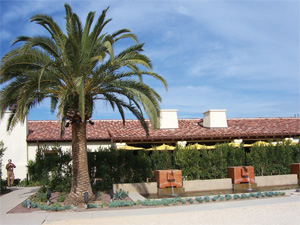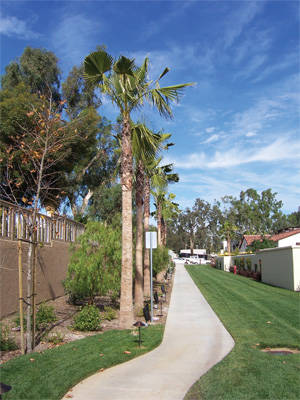
Washingtonia robusta, a Mexican fan palm, is a low-maintenance tree, though it requires annual pruning to look its best. There are 97 Mexican fan palms on the property.

Miguel reports there is some lerp psyllid infestation of the red gum eucalyptus trees. Psyllids, native to Australia, are small insects that suck sap from the leaves and produce a sticky substance called honeydew that drops to the ground. They can weaken a tree and make it more susceptible to attack by other insects. Psyllids were discovered in Los Angeles in 1998 and have spread throughout much of the state.
“There’s really nothing to stop them,” say Ric. “We release the wasp, which has been very successful in many areas, but getting ride of them (the pest) is almost impossible.”
The wasp is the female parasitoid, which lays her egg inside a psyllid egg. When the wasp hatches, it dines on the psyllid. The psyllid is now just a shell (‘mummy’) that’s quite a nice home for junior wasp. When junior is ready to take wing, it simply eats an exit hole.
The mature eucalypti, of course, are long existing trees on the property, still, 165 15-gallon eucalyptus sp. were planted. Other trees include 52 California peppers; 47 Hollywood junipers; 43 Torrey pines; 39 candelabras (Euphorbia continifolia); 31 Valencia dwarf orange; 27 Italian cypress; 23 dwarf lemon; 21 dragons (Dracaena draco); a variety of palms (97 Mexican fan, 37 sago); olive; sycamore (at the entry, though at this time of year they are bare); aloe bainsii; Chinese elm and magnolias. Four marina strawberry trees were specified for the courtyard but wilted from the heavy rains.
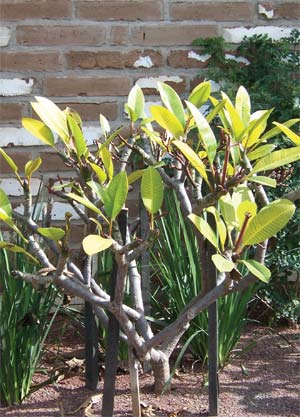
The outdoor areas for spa treatments have been modified to provide more privacy. There is now a double row of ficus and 15-foot clubbing bamboo.
With only two months before the spa’s grand opening, Rick Jensen realized no plans had been made for interior plants. Ric Crisp of Park West recommended Steve Wolff and Associates. Rick opted for a plant/container lease and horticultural maintenance program, an affordable alternative to buying the plants and expecting the landscapers to care for them. Matt Nowicki handles the interior plants (30-40), plus the outside “buffer” of potted plants. Rick says that contract is $960 a month, but he expects it to increase by half as much this year. There’s exterior color pot maintenance, plus 4-5 hours of interior pot maintenance each week. Guests have been known to pour drinks into the pots.
When I ask about drainage, wondering how the property is holding up under the unusually heavy winter rains, I get a rise from everyone.
“On the west side of the property there is heavy drainage from the adjoining upslope property,” explains Ric Crisp. “It’s an inherited problem,” he adds. The city is attempting to resolve the issue, but meanwhile water is invading the spa’s row of citrus trees, whose fruit is now drooping, a result of the inadvertent overwatering.
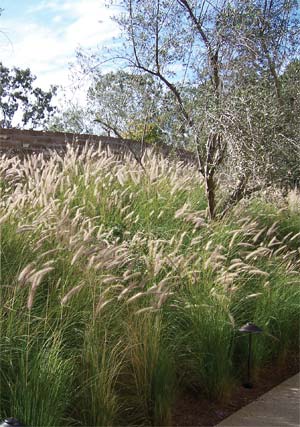
Rick Jensen explains the drainage is pre-existing (NDS), the result of plans by various developers over the last 10-20 years to build a hotel here.
“About 10 years ago they laid conduit on the south of the property and rebuilt the 60,000 gallon retention pond. There are over 500 individual drain connections into the system. I have 40-50 that were not placed properly. You don’t know that until, like over the last couple of weeks, you get a good rain. There are some drains that are 3-6 inches up the hill from the low spot. So we’re working through that and relocating those 40-50 drains.”
“The biggest challenge to maintaining the property?” Miguel says it is the new landscaping. It is “still adapting,” he says. With the heavy rains, coupled with some drainage problems, his crew is closely monitoring how the plants are doing, not a small job, as there are 23,000 plants.
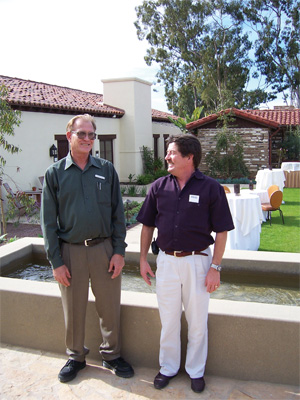
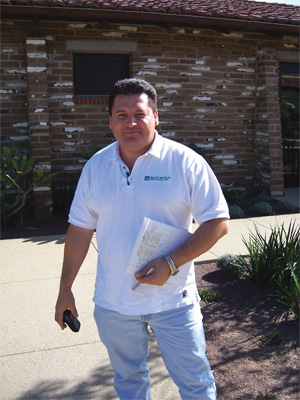
“We’ve have many succulents,” Ric explains. “The plants have to contend with the coastal wind and salt. Some plants can’t tolerate one or either of those conditions, so that’s why Miguel is paying such close attention.” But the most crucial issue to Ric is monitoring the irrigation. “What’s nice is the irrigation system is new, state-of-the-art. We don’t have conditions like some of the old properties in San Diego–shurb beds mixed with turf, turf mixed with succulents. We can multi-program the controllers.” There is one drawback to the drip system, Ric specifies. “There is no injector system, so fertilization is a difficult thing to deal with. The crew has to put down granules, which is a lot more labor intensive.”
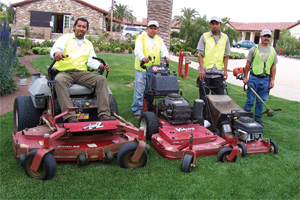
Miguel says that filters need to be added to the drip system. He expects to present a proposal in that regard. “Many times maintenance and construction are totally separate animals,” notes Ric. “We?EUR??,,????'???ve come in on the maintenance side and this is what we’ve got. Some of the things that were done just don’t work from the maintenance side. Maintenance personnel should be present at pre-construction meetings to give feedback,” he asserts.
“This is Destination Resorts’ first project built from the ground up, so it is a learning curve for us,” Rick Jensen says. He has input data on every aspect of the building of the hotel and its landscape and has made recommendations how to be more efficient and cost effective next time around. “Some of those recommendations would have cost more up front, but would have saved three times that much on the back end, and the opening would have been smoother.”
